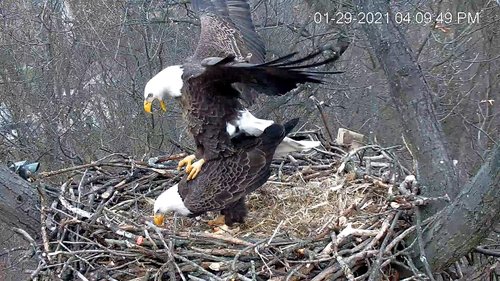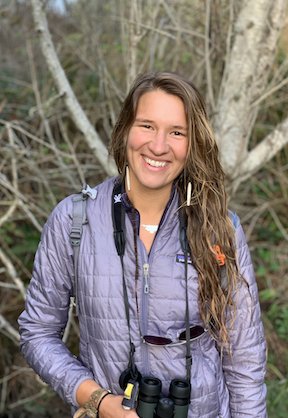Hanover Bald Eagle Blog # 5 - 2021
Feb. 1, 2021
In partnership with Pennsylvania Game Commission and Comcast Business .

ON JANUARY 29TH AND 30TH THERE WERE SEVERAL OBSERVED COPULATIONS AT THE HANOVER NEST, SUGGESTING THAT, AS OUR COMMUNITY OF OBSERVERS PUT IT, LOVE IS IN THE AIR!
Copulations may occur several times in one day, and although the pair’s primary incentive is fertilization, copulation and other intimate behaviors can also play a role in strengthening the bond between mates. As observers, we cannot tell if fertilization occurs in the moment, however, 5 to 10 days later, proof could show up in the form of an eagle egg!
Most birds are cued into breeding season by environmental triggers such as photoperiod, a fancy word for changes in day length. This information is absorbed by the bird’s eyes and then transferred to a part of their brain called the hypothalamus, resulting in the release of reproductive hormones. These hormones are responsible for physiological developments as well as behavioral ones - testosterone production, ovary growth, singing, and courtship displays, to name a few. Social interactions also play a role in reproductive readiness, although this is a difficult cause-and-effect to study.
Environmental cues can also be region-specific and species-specific. For example, in arid climates, some species are triggered into reproductive readiness by an increase in rainfall. In New Zealand, male ground-dwelling parrots called Keas begin sperm production as the days shorten rather than lengthen. The breeding cycle of red crossbills is tied to the availability of conifer seeds, and they therefore breed opportunistically. In other words, crossbills reproduce when trees reproduce!
Important components within the male reproductive system include gonads/testes (yes, gonads is a technical term) and a deferent duct, the channel sperm travel through on their way from the gonads to a storage unit called the cloaca. The cloaca is an exit chamber unique to birds through which feces, urine, and eggs are released. Both males and females have a cloaca. The female reproductive system includes the ovary, ovum and oviduct. After fertilization, the ovum, which is the mature female reproductive cell, journeys through the oviduct where it undergoes a series of transitions that turn it into a full blown eagle egg!
But how does fertilization even occur if birds don’t possess the same equipment as mammals? (see Fun Facts at the end of this blog for an exception to this rule).
The act is called copulation, and involves the everted (opposite of inverted) cloaca of both male and female coming into contact in a what is called the “cloacal kiss,” during which sperm is transferred to the female. This behavior requires a balancing act, whereupon the male gently perches on the female’s back, curling his talons so as not to hurt her. Both birds work to align their cloaca, and as we saw this week, the meeting is quite brief.
Once sperm has entered the female’s body, it remains in a storage unit. Female birds store sperm for varying lengths of time, depending on species-specific life history traits such as how many eggs the female lays, or how much time elapses between male and female “date nights.” Chickens store sperm for up to 30 days, pigeons for up to six days, and black-browned albatrosses, which maintain long-distance relationships where the male is out at sea for months at a time, can store sperm for up to two months! To make fertilization even more interesting, bird ova actually require more than one sperm for fertilization, called polyspermy. This phenomenon exists in the reproductive processes of sharks, newts, and salamanders as well.
Once the ovum is released and meets sperm, a process initiated by either an internal clock or social cues, fertilization may occur. If so, minutes later, the ovum travels down the oviduct and egg formation begins in earnest. If the Hanover pair was successful this week, we may see the result in the near future. Stay tuned to learn more about egg production next week, and keep your eyes peeled for an elliptical addition to the Hanover nest!
FUN FACTS
- Vocals and body posturing sometimes preface copulation, and while it’s difficult for scientists to verify the reason behind this, it’s entirely possible that male and female eagles greet each other, talk things out, and/or egg each other on (literally). Communication takes on more than one form for humans and eagles alike.
- Interestingly, waterfowl and some flightless birds including emus have a “copulatory organ” which is another name for we-all-know-what that is not the same as that of a mammal because there is no internal urethra.
- Female birds can generally lay viable eggs well into “old age.” In fact, elderly California Gulls can produce more during their final years, theoretically to give it one last go and ensure their genetic material will live on.
- Bald eagles in Florida start breeding in November, meaning their reproductive systems are using a different primary cue. For birds breeding closer to the equator, day length is not as strong of a trigger because the difference between the longest and shortest days is not as stark as further North. Therefore, it may be that daily light intensity rather than length initiates changes in the reproductive systems of Floridan bald eagles, where light intensity increases in September.
SOURCES
Birkhead, Tim (2017). The Most Perfect Thing. London. Bloomsbury Publishing PLC.
Gerrard, Jon M. and Bortolotti, Gary R. (1988). The Bald Eagle, Haunts and Habits of a Wilderness Monarch. Smithsonian Institution.
ATTENTION HANOVER EAGLE VIEWERS - We recognize that over the years this bald eagle pair has been named by the public and is commonly referred to as "Freedom" and "Liberty". While we understand that naming the eagles helps connect and distinguish the female from the male eagle, naming the pair introduces an element of domesticity to wild animals. In order to respect the eagles and focus on their natural history, we will refer to the female and male as such as per recommendations of the Pennsylvania Game Commission.

RETURN TO HANOVER BALD EAGLE BLOGS
WATCH THE HANOVER BALD EAGLE LIVE CAMS
For over 20 years, HDOnTap has provided live streaming solutions to resorts, amusement parks, wildlife refuges and more. In addition to maintaining a network of over 400 live webcams, HDOnTap specializes in design and installation of remote, off-grid and otherwise challenging live streaming solutions. Contact press@hdontap.com for all media needs, including images and recordings.